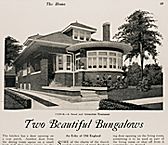| Entries |
| B |
|
Bungalows
|

|
Within the city limits, a common form of bungalow was a rectangular brick structure with a modestly pitched, hip-raftered roof and a small distinctive front porch. It fit on narrow city lots and followed the floor plan of earlier one-story working-class houses. However, builders constructed a great variety of structures even in the city's classic “ bungalow belt. ” Variety was still more common in the suburbs, especially those with larger lots that allowed builders greater freedom. Suburban bungalows were often one-and-one-half-story frame structures with steeply pitched roofs. These houses had bedrooms on the second floor, separated from the kitchen, parlor, and dining room.
By 1930, one-fourth of all residential structures in metropolitan Chicago were less than 10 years old, many of them bungalows, ranging in cost from about $2,500 to $10,000. A form of bungalow continued to be built in working-class areas of the South Side in the 1960s. However, the bungalow lost popularity among house buyers after World War II, as ranches and split-levels became the dominant house forms in new areas. Recently, “historic” bungalows have resurged as popular housing in gentrifying areas of the city. Promoters have praised the aesthetic virtues of an older style, most notably its woodwork and “craftsmanship.” However, location and affluence apparently matter more than aesthetic values. In poor areas of the city, the same types of bungalow serve as affordable but out-of-date housing.
The Encyclopedia of Chicago © 2004 The Newberry Library. All Rights Reserved. Portions are copyrighted by other institutions and individuals. Additional information on copyright and permissions.